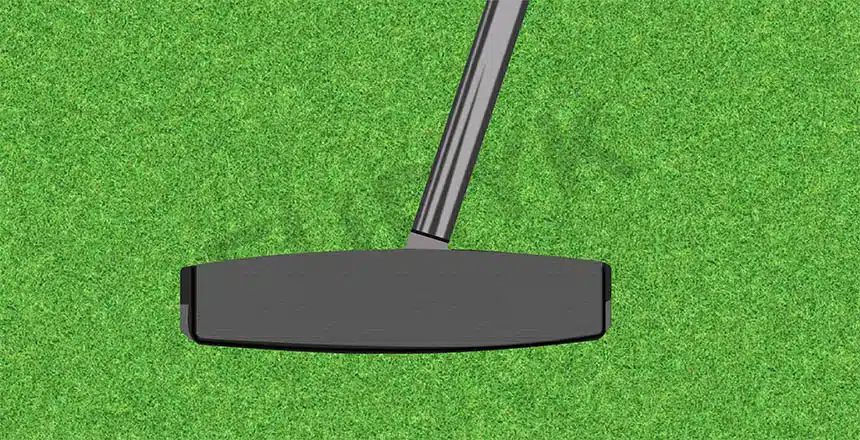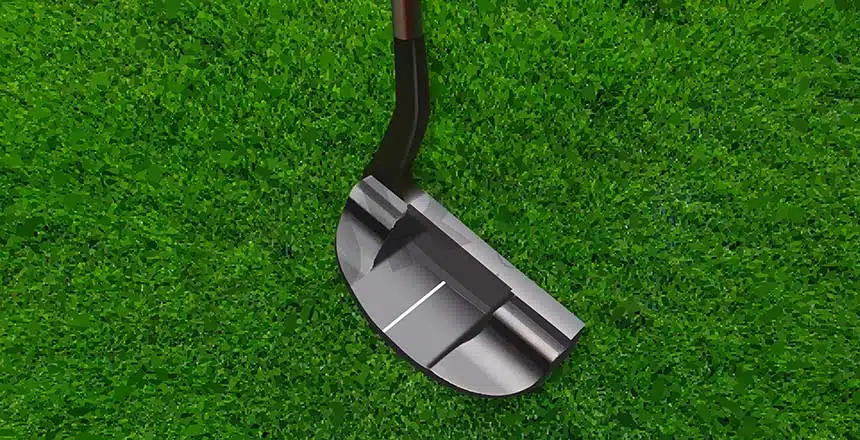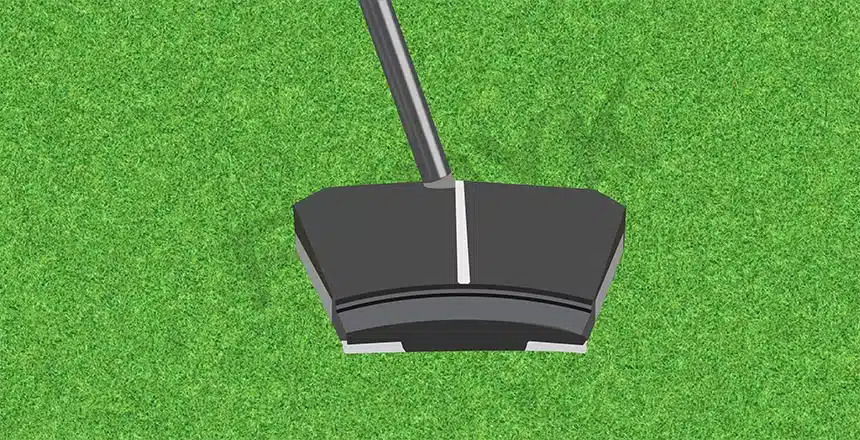Does a center-shafted putter actually help? This article is all about finding not just the right answer but also getting to the bottom of the whole design and purpose of center-shafted putters in golf.
Choosing a brand new putter for your short game is not as simple as walking into a store and just buying the golf club based on, for example, only the correct putter length. You have to take into account several other factors as well, which include how the shaft of the putter is connected to the head.
So you get two options to select from here – heel-shafted putters and center-shafted putters.
In this post, I’m going to mainly focus on both the advantages and disadvantages of a center shafted putter (the benefits are the highlight indeed). And also pit the center-shaft design against its heel-shafted version. So you can make a more well-informed decision the next time you walk into that shop to buy a new putter.
Center-Shafted Putters – What It Is?

Short and concise – These types of golf putters consist of the shaft entering or fitting into the clubhead straight through the middle i.e. closer to the sweet spot, sightline, and aiming aid.
As for the other kinds of putters, they have the shaft attached to the heel (hence, heel-shafted putters) instead of the center of the clubhead. The heel portion of a club lies the closest to you during address while the toe is the farthest. Also, putters seem to be the only golf clubs that can be center-shafted.
In This Post
What Are the Benefits of A Center-Shafted Putter?
Now here’s why you should be using a putter that’s center-shafted…
1. Greater, Better Feedback
Isn’t feel an important aspect of your game, both long and short? Gaining that extra feedback during putting is nothing but a massive benefit as it encourages the much-preferred lower positioning of the hand through your putting action.
2. Added Control
Center-shafted hosel-type putters provide extra control too, which is also another plus or preference that many golfers look for when executing their putting technique/style.
3. Reduced Twisting Action
Twisting of the shaft naturally has an impact over the clubface, especially near its toe area. In standard putters, when the shaft or heel (same thing) twists, this twisting effect tends to get amplified near the toe end.
On the other hand, with a center-shafted putter, the space between shaft and toe is literally reduced by half. And this reduction means even the extent to which the toe receives the impact decreases. So the effect of that twisting action is not as amplified with center-shafted putters as is the case with their heel-shafted counterparts.
4. Most Suitable for Straight-Back-Straight-Through Putting Stroke
When talking about center-shafted putters, you think of them as face-balanced putters, which is almost always right. And the face-balanced design, no doubt, works very well for golfers with a straight-back-straight-through putting style.
Just picture a flawless straight line running along through the putter center to your target. Therefore, that putter head is sure to move along that target line (thus, straight-back-straight-through).
So you don’t have to actively make an effort for taking the clubhead inside at the time of your backswing and follow-through to achieve the same (also described as the inside-to-inside approach adopted for the arc putting stroke).
5. Works for Left Eye Domination
If it’s your left eye that’s the dominant one in golf (meaning you’re a right-handed golfer), then a center-shafted putter is the correct pick for you.
Simply form a triangle using your hands and find a target object in view (at a distance of around 10 meters). Whichever one of your two eyes keeps in focus that target object when the opposite eye is closed is the dominant eye. For instance, upon shutting the right eye, you can focus on your object with the left one, then your left eye is dominant. As for the weaker eye, it will be blocked partially because of your hand.
Advantages of A Center-Shafted Putter
- Simple, straightforward alignment aid.
- Minimal twisting action during putting.
- Greater feedback and control throughout putting style.
- Perfect for the straight-back-straight-through technique.
- Works really well for golfers with left eye domination (right-hand orientation).
Disadvantages of A Center-Shafted Putter
- Minimal or no offset, thus greater push (miss to the right) tendencies.
- This face-balanced design is not suited for the arc putting stroke.
- Interferes with alignment since the shaft gets in the way of your eyeline.
Difference Between Center-Shafted and Heel-Shafted Putters

First and foremost, if your putting stroke has an arc style (higher hands), you should be using a heel-shafted putter. While center-shafted putters are more fitting for those with a straight-back-straight-through or pendulum putting approach (lower hands).
As for the difference between these two types of golf putters, it all comes down to weight distribution. With the center shaft, the hosel connects the club shaft to the head in the CENTER (or sometimes it could connect slightly closer to the heel).
The main thing here is that the center-shafted putter design is face-balanced, which just means that the clubface gazes upward when you balance that putter on the hand.
Then comes the heel-shafted putter with its hosel connecting the shaft to the head in the HEEL. Heel-shafted also means toe-balanced – here the clubhead toe is pointing downward. These are also called blade putters and they rank as the best in terms of how great they look on those greens.
Related: Blade vs. Mallet Putters
However, it’s in your best interest to choose between the two based on your natural putting technique, straight-back-straight-through or arc.
Difference Between Straight Shaft and Offset Shaft Putter
With putters that have an offset (offset in golf clubs), the head is positioned further back in comparison to the shaft’s longest part. And this kind of design is better for golfers who are well aware of their putting stroke and form. Mostly, it’s for those who practice/master the arc putting style.
While a center-shafted putter is more suitable for straight-back-straight-through.
See, the thing here is that you need a putter that encourages consistent setup and alignment. In that case, if you get the task done, which also includes starting the golf ball on the desired target line, more consistently with an offset-shafted putter, then that’s great.
Although an improvement in alignment and setup is more likely and common with a straight shaft putter i.e. no offset.
Are Center-Shafted Putters More Suited for Beginners?
Beginners ought to be using an extremely forgiving putter, which is usually one of the heavier (mallet-style) putters. They offer lots and lots of mis-hit forgiveness through a larger sweet spot.
But then what about center-shafted putters, are they more in tune with the putting style and skill of beginners? Yes, because beginners, more often than not, use this very design when they get into the game of golf. And it works just fine.
The more important thing to remember here is that if you can control the clubface, then employ the right approach to make the most of that putting style of yours.
Do Pros Use Center-Shafted Putters?
The majority of PGA Tour players choose heel-shafted putters because these are more suitable for their arc putting stroke. But there are those (for example, Zach Johnson) who prefer swinging long or belly putters that use the center-shafted version instead.
Are Center-Shafted Putters Bad?
Center-shafted putters are definitely not for you if you have a strong arc putting style.
Aside from that, the center-shaft option can indeed be a little distracting in terms of its shaft placement interfering with the aiming or alignment markings on the golf ball.
Moreover, with center-shafted putters, you get a slightly reduced dynamic loft. As a result, this might give rise to a poor roll.
Related: Best TaylorMade Putters for A True Roll & Solid Sightline
Can Center-Shafted Putters Bend?
Bending center-shafted putters can be done without messing with the clubface balance. Even so, do so with caution to prevent the shaft from snapping off. In simple words, don’t be too rough or careless.
For instance, if your too-straight-shafted putter’s angled around 72 degrees, then you can slowly bend it to 67 or 68 degrees.
Are Center-Shafted Putters Face-Balanced?
Center-shafted putters are face-balanced, thus more suitable for the straight-back-straight-through putting approach. To put it simply, face-balanced implies that the clubface will be facing upward when the putter is balanced on your hand or finger.
The opposite of this (toe-balanced – facing down toward the ground) takes the form of a heel-shafted putter. With this type of construction, the face squares up more easily during the arc putting stroke.
That’s ALL You Need to Know About Center-Shafted Putters
When we look at putting, it all comes down to factors like feel, consistency, and confidence. So if you ever happen to use a putter that truly feels good and boosts your confidence, never let that putter go.
But, on the other hand, if you’re struggling with your putting game, then consider buying a center-shafted putter, even though this design is quite underrated and even unlike other more commonly spotted putters out there.
And maybe also try two center-shafted putters manufactured by different brands. Agreed that the overall design looks almost identical, nevertheless one of them is sure to work better for YOUR style of play than the other.


I just tried left hand centre balanced putter with right hand low, instead of usual right hand putter with right hand down.
It worked and felt quite good even on long putts.
Why would that be?
I suggest a bullseye putter. For SBST putting easy alignment I am 64 year old man. Using it since 1982. I tried every putter you can name. Always come back to bullseye. Hard to beat the feel of the yellow brass putter head.